Asus Mars 760 Review: Two GPUs In SLI; One $650 Graphics Card
We like the idea of two GK104 GPUs in SLI on one graphics card. Sounds like a GeForce GTX 690, right? Except that board costs $1000 and Asus' Mars 760 sells for $650. In a world with sub-$700 GeForce GTX 780 Tis, can this dual-GPU stunner still impress?
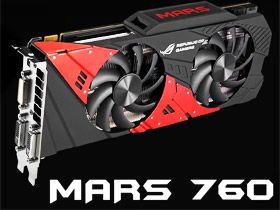
Two GK104s On A Card For $650
Every single day, your favorite vendors send in requests to have their products reviewed by Tom's Hardware. We typically try to maximize the number of components presented to you, our readers, by organizing round-ups. There's a lot more to be learned, we think, by comparing the strengths and weaknesses of many competing offerings. But occasionally, a unique specimen surfaces so unlike everything else that we devote an entire story to it. Today we're looking at Asus' Mars 760, a graphics card with no peer. To test it, we have to reach into our collection of cards for relevant data points.
This isn't the first board in Asus' Mars family, and if you're familiar with the brand, then you already know the ROG MARS760-4GD5 boasts two Nvidia GPUs (Asus reserves the Ares brand for its dual-Radeon creations). All semblance of suspense is relieved by the model number: 760 gives away the fact that we're looking at a couple of GK104 processors. And incidentally, they're overclocked, too.
| Header Cell - Column 0 | 2 x Radeon HD 7950 Boost | Radeon HD 7990 | Radeon R9 290X | Asus Mars 760 | GeForce GTX Titan | GeForce GTX 780 Ti | GeForce GTX 690 |
|---|---|---|---|---|---|---|---|
| Shaders | 3584(2 x 1792) | 4096(2 x 2048) | 2816 | 2304(2 x 1152) | 2688 | 2880 | 3072(2 x 1536) |
| Texture Units | 224(2 x 112) | 256(2 x 128) | 176 | 192(2 x 96) | 224 | 240 | 256(2 x 128) |
| ROPs | 64(2 x 32) | 64(2 x 32) | 64 | 64(2 x 32) | 48 | 48 | 64(2 x 32) |
| Fab Process | 28 nm | 28 nm | 28 nm | 28 nm | 28 nm | 28 nm | 28 nm |
| Core (Boost) Clock | 850 (925) MHz | 950 (1000) MHz | (1000) MHz | 1006 (1072) MHz | 837 (876) MHz | 875 (928) MHz | 915 MHz |
| Memory Clock | 1250 MHz GDDR5 | 1500 MHz GDDR5 | 1250 MHz GDDR5 | 1501 MHz GDDR5 | 1502 MHz GDDR5 | 1750 MHz GDDR5 | 1502 MHz GDDR5 |
| Memory Bus | 384-bit | 384-bit | 512-bit | 256-bit | 384-bit | 384-bit | 256-bit |
| Memory Bandwidth | 240 GB/s | 288 GB/s | 320 GB/s | 192.2 GB/s | 288.4 GB/s | 336 GB/s | 192.2 GB/s |
| TDP | 400 W(2 x 200 W) | 375 W | 250 W | 300 W (per Asus) | 250 W | 250 W | 300 W |
| Amazon Price Range | $840 to$860 | - | $630 to $780 | $650 | $1000 to $1849 | $680 to $770 | $995 to $1350 |
| Typical Price | $840 | - | $650 | $650 | $1000 | $680 | $1000 |
Asus' packaging claims that the Mars 760 is about 7% faster than a GeForce GTX Titan, though at its $650 price point, it's really competing against the Radeon R9 290X and GeForce GTX 780 Ti. I didn't have a 780 Ti on-hand, so I'm tuning my Titan to approximate the more gaming-oriented card's performance.
Speaking of operating frequencies, the Mars 760 sports a 1006 MHz base and 1072 MHz typical GPU Boost clock rate, which is a little higher than the 980 MHz Nvidia guarantees its GeForce GTX 760 for. Asus uses 4 GB (2 GB per GPU on independent 256-bit buses) of GDDR5 memory at the same 1500 MHz as the reference 760.
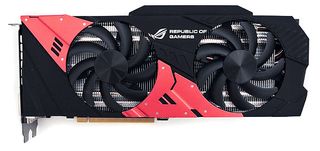
The Mars, Ares, and Matrix graphics cards exist under Asus' Republic of Gamers (ROG) brand. Naturally, the first thing you'll notice about the Mars 760 is its distinct red metal-on-black shroud. It weighs 2.1 lbs (970 grams) and measures 11" x 5" x 1.5" (28 x 12 x 4 cm), making it large, but no bigger than single-GPU products like the Radeon HD 290X and GeForce GTX 780.
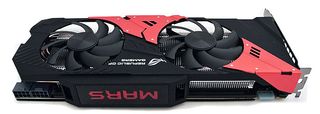
Plugged in and powered up, the word Mars slowly "breathes" thanks to red LEDs behind the name plate.
There is one SLI connector; Asus says it worked closely with Nvidia to enable four-way operation with a second card (since GeForce GTX 760s typically don't scale to four-way configurations).
Stay On the Cutting Edge: Get the Tom's Hardware Newsletter
Get Tom's Hardware's best news and in-depth reviews, straight to your inbox.
Also, you'll need two eight-pin auxiliary power connectors. Nvidia cites a 170 W graphics card power figure for one GeForce GTX 760. Meanwhile, Asus says its card should fall closer to 300 W, with spikes higher if you run more taxing apps like FurMark. A PCIe slot is rated for up to 75 W; an eight-pin lead should be good for up to 150 W; a six-pin connector officially serves up 75 W as well. Although we've seen plenty of cards pull more power than their inputs were officially rated for, it's pretty clear why Asus felt two eight-pin connectors were necessary in this case.

A side view gives you a peek into Asus' DirectCU II cooler, which employs eight copper heat pipes (four per GPU). Two low-profile 85 mm fans blow through the sink's fins to keep the GPUs running efficiently. The company claims these are dust-proof, but we'll believe that after a year or two of real-world use.
Hidden under the cooler is a 12-phase VRM, which may play a role in overclocking. This will get tested later in today's story.
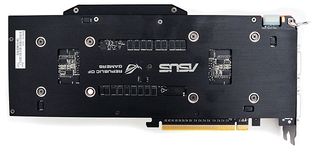
As part of its marketing message, Asus says the Mars 760 only uses Japanese Nichicon GT-series capacitors and other high-quality components like super alloy power chokes, MOFSETS, and POSCAPs.
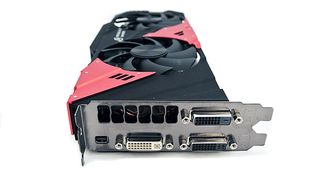
The Mars 760 is equipped with two dual-link DVI-I, one dual-link DVI-D, and one mini-DisplayPort output. HDMI is also covered by a bundled adapter.
Current page: Two GK104s On A Card For $650
Next Page The Mars 760 Bundle And Software-
vinhn @AMD Radeon, everyone would like to see it, not everyone would buy it, the market knows that, there's a reason why they would rather release the dual 760 rather than a 1600$ dual 780 Ti.Reply -
vertexx I'm not sure why you would even publish this review without a 780ti in the comparison.Reply -
Shneiky It was actually disappointing that there was no regular 760 SLI in there. It would have helped to see if the Asus's solution gives better results then regular 2 760s.Reply -
bemused_fred Looking at the way that various card configurations bounce around in the charts, with the ranking of cards varying from page to page, the only thing I'm taking away from this article is not to bother with dual-GPU set-ups. It seems their performance is entirely decided by how well-optimised the games are for Nvidia or AMD, and not their actual specs.Reply -
Adroid I'm confused why the 780 and 770 aren't shown here - especially since the 780 is at the same price point.Reply -
Au_equus without the gtx 780 ti, you are missing half the article, as ASUS, according to the price, was presenting this card as an alternative to the 780 ti at its price/performance. I stopped reading after the first BM.Reply
